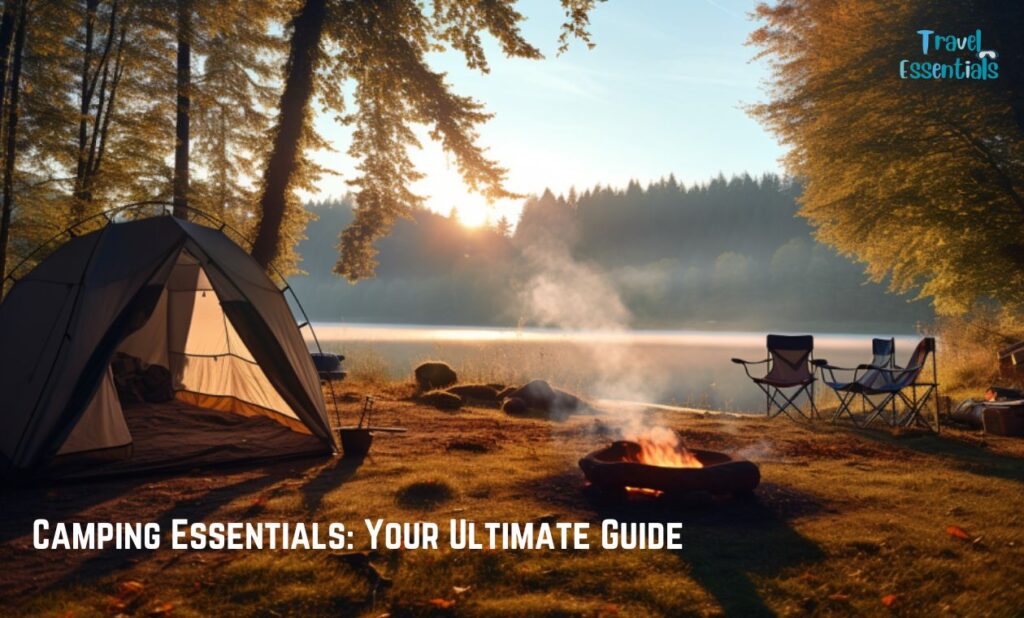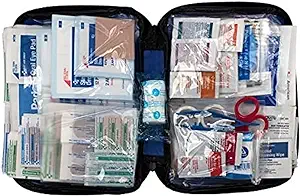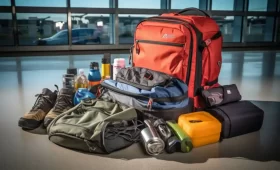Nature Connection: Camping and Outdoor Adventure Tips

A breath of fresh mountain air, the crackling of a campfire, and the serenity of sleeping under a starlit sky—camping and outdoor adventures offer an escape from the hustle and bustle of daily life. There’s an innate allure to connecting with nature, one that draws adventurers of all kinds to the great outdoors. But in this enchanting wilderness, where the possibilities are endless, comes the need for proper preparation and knowledge.
Camping and Outdoor Adventure Tips are your compass to navigate this world of natural wonders. Whether you’re an experienced outdoorsman or a novice explorer, this guide is your key to unlocking the full potential of your outdoor escapades.
In the following sections, we’ll delve into the art of preparation, the intricacies of setting up camp, the thrill of outdoor activities, and the importance of safety and sustainability. We’ll share wisdom on creating sumptuous meals in the wild, embracing the magic of starry nights, and making outdoor adventures unforgettable for your family and kids.
Nature is calling, and it’s time to answer. Let’s embark on a journey together—one filled with adventure, connection, and harmony with the natural world. Whether you’re a seasoned camper or a curious newcomer, these tips will enrich your outdoor experiences and ensure your every escape is a memorable one.
So, tighten those hiking boots, grab your backpack, and get ready to explore the wilderness. The great outdoors awaits your discovery!
Preparing for Your Outdoor Adventure
A journey into the wilderness begins long before you set foot on the trail. Adequate preparation is the compass that guides you through the intricacies of outdoor living. Here, we embark on the first leg of our journey by delving into the essential steps of preparing for your outdoor adventure.
Imagine gearing up for a concert; you wouldn’t want to arrive without your favorite instrument. Similarly, selecting the right camping gear and equipment tailored to your adventure is pivotal. Your choices can significantly impact your comfort and safety.
From tents that shield you from the elements to sleeping bags that cradle you in warmth, gear selection requires thoughtful consideration. The golden rule is to balance durability with weight and functionality. Seasoned campers often swear by the ‘less is more’ mantra, opting for versatile, lightweight gear that eases their journey.
Every great adventure starts with a plan. The same applies to outdoor escapades. Research, scouting, and understanding the lay of the land are key components of a successful trip. Begin by defining your objectives. Are you chasing adrenaline through mountain trails, or seeking serenity by a tranquil lakeside?
Next, scout for suitable camping locations. Factors like accessibility, terrain, and proximity to water sources are crucial. National parks, forests, and campgrounds offer an array of choices, each with its unique charm. Detailed planning includes setting up a realistic itinerary, accounting for travel time, activities, and rest.
Safety should never be an afterthought when exploring the wilderness. Nature’s unpredictability demands that you equip yourself with knowledge, tools, and essentials to mitigate risks. Study the environment you’re entering, understanding its fauna, flora, and potential hazards.
First-aid kits, navigation tools, and communication devices are your lifelines. Remember, it’s not just about packing these items but knowing how to use them effectively. Basic survival skills are invaluable, and sharing your itinerary with someone back home can be a vital safety net.
Your adventure is only as successful as your preparations. By choosing the right gear, meticulously planning your trip, and prioritizing safety, you pave the way for an unforgettable outdoor experience.
Setting Up Camp
Setting up camp is where the wild truly becomes your home. It’s a delicate balance between shelter, sustenance, and safety. In this segment, we’ll dive deep into the art of creating your outdoor haven.
Tips for Setting Up Your Campsite Efficiently and Safely
Choosing the perfect campsite is both an art and a science. Start by considering the ‘Leave No Trace’ principles, ensuring your presence in nature has minimal impact. Opt for established campsites when possible to minimize disturbances.
When setting up your tent, scout for level ground and clear any debris that might pierce your tent’s floor. Ensure your tent is well-ventilated to avoid condensation, and if possible, orient it to maximize natural light. Additionally, familiarize yourself with your surroundings. Know the location of water sources, emergency exits, and potential hazards.
Building a Fire and Campfire Safety
A campfire is more than just a source of warmth and light; it’s a symbol of camaraderie and storytelling. However, with great fire comes great responsibility. Follow these steps to kindle your campfire safely:
- Clear the area: Remove leaves, twigs, and any flammable material from the vicinity.
- Use a fire ring or pit: If available, use established fire rings or pits. If not, create a fire pit by digging a shallow hole.
- Gather firewood: Collect dry, dead wood from the ground. Do not break branches from living trees.
Respect fire regulations: Familiarize yourself with local fire regulations and adhere to them.
Once your fire is roaring, maintain it at a manageable size. Keep a bucket of water or a fire extinguisher nearby and never leave the fire unattended.
Cooking and Meal Preparation in the Outdoors
Outdoor cooking can be a delightful experience, but it requires a degree of planning and skill. Invest in lightweight, portable cookware that suits your needs. Opt for a camp stove if campfire cooking isn’t an option or isn’t allowed due to fire restrictions.
Plan your meals in advance and consider the weight and shelf-life of ingredients. Remember to pack utensils, plates, and cookware suited for outdoor use. Practice Leave No Trace principles by properly disposing of food waste, and always wash your dishes and cooking equipment away from water sources.
With your campsite set up, a safe campfire dancing in the night, and the aroma of a well-prepared outdoor meal, you’re not just camping; you’re embracing the essence of outdoor living.
Outdoor Activities and Adventure
Now that you’ve mastered the art of setting up camp and taming the wilderness, it’s time to explore. Outdoor adventures offer a chance to connect with nature, challenge yourself, and create unforgettable memories. Here, we delve into various activities that will elevate your outdoor experience.
Hiking and Trekking Tips for Different Terrains
Hiking is the gateway to the heart of the wilderness. Whether you’re exploring rugged mountain trails, serene forests, or arid deserts, a successful hike begins with the right preparation:
- Know your trail: Research your chosen route thoroughly, including its difficulty level and potential hazards.
- Gear up: Invest in sturdy hiking boots, moisture-wicking clothing, and appropriate layers. Don’t forget essentials like a map, compass, and a well-stocked first-aid kit.
- Stay hydrated: Carry an ample supply of water and know where water sources are located along the trail.
- Leave no trace: Adhere to Leave No Trace principles. Stay on marked trails, pack out all waste, and respect wildlife and plants.
- Safety first: Inform someone of your hiking plans, including your estimated return time.
- Trekking through varied terrains requires different skills and gear. Whether you’re summiting peaks, traversing through dense forests, or crossing desert landscapes, the key is adaptability and preparation.
Water-Based Activities Like Kayaking, Fishing, and Swimming
Water is a playground for outdoor enthusiasts, offering activities like kayaking, fishing, and swimming. Before you dive in, remember these tips:
- Safety is paramount: Wear appropriate life jackets and safety gear, especially when kayaking or swimming in unfamiliar waters.
- Check regulations: Be aware of local fishing regulations and obtain the necessary permits.
- Respect aquatic life: Practice catch and release to conserve fish populations. Be mindful of nesting birds and other wildlife near water bodies.
Whether you’re silently gliding across serene lakes in a kayak, casting your fishing line into a sparkling river, or taking a refreshing dip in a mountain stream, water-based activities connect you with the tranquil beauty of the outdoors.
Wildlife Encounters and Responsible Outdoor Behavior
One of the most captivating aspects of outdoor adventures is the potential for wildlife encounters. Observing animals in their natural habitat is a privilege, but it comes with responsibilities:
- Maintain a safe distance: Respect the animals’ personal space. Use binoculars or a telephoto lens for close-up views.
- No feeding: Feeding wildlife can disrupt their natural behaviors and diets. Keep your snacks to yourself.
- Quiet observation: Speak in hushed tones and avoid sudden movements that may startle animals.
Remember, you are a guest in their home. By adhering to ethical wildlife viewing practices, you can enjoy the magic of encountering animals without causing harm or stress.
Embarking on outdoor adventures opens a world of exploration and wonder. Whether you’re scaling peaks, paddling serene waters, or simply savoring the sights and sounds of nature, these experiences are the essence of outdoor life.
Staying Safe and Healthy
Amidst the beauty of the great outdoors, safety and health should always be a top priority. In this section, we dive into essential practices and tips to ensure your well-being while camping and engaging in outdoor adventures.
First Aid and Emergency Preparedness
First Aid Kit: A well-stocked first-aid kit is your lifeline in the wilderness. It should include bandages, antiseptic wipes, pain relievers, tweezers, and any personal medications.
Know Basic First Aid: Familiarize yourself with basic first-aid techniques. Online courses or wilderness first-aid classes can be invaluable.
Emergency Contact: Always carry a list of emergency contacts and know the nearest medical facilities.
Communication: In remote areas, consider satellite phones or personal locator beacons (PLBs) for emergency communication.
Leave an Itinerary: Before heading out, share your trip details and expected return time with a trusted contact.
Hygiene and Sanitation in the Wilderness
Leave No Trace: Follow Leave No Trace principles, which include packing out all waste, using established toilet facilities or digging cat holes, and keeping water sources clean.
Biodegradable Soap: Use biodegradable soap for washing dishes and yourself, keeping in mind that even biodegradable soap should be used at least 200 feet away from water sources.
Hand Sanitizer: Carry hand sanitizer and use it before handling food or after using the restroom.
Toilet Trowel: A lightweight, portable trowel is essential for digging cat holes for human waste disposal.
Staying Healthy and Dealing with Common Outdoor Ailments
Stay Hydrated: Dehydration is a common outdoor ailment. Drink plenty of water, even in cool weather, and know how to find and purify water sources.
Protect from Sun and Bugs: Use sunscreen and insect repellent to protect your skin from sunburn and insect bites.
Dress Appropriately: Dress in layers to regulate body temperature and prevent hypothermia in cold weather.
Foot Care: Keep your feet dry and comfortable by wearing moisture-wicking socks and well-fitting, broken-in boots.
Nutrition: Maintain proper nutrition with a balanced diet. High-energy snacks are crucial for keeping your energy up during hikes.
Know Common Ailments: Learn to recognize and treat common outdoor ailments like blisters, sprains, and altitude sickness.
Wildlife Safety: Educate yourself about the wildlife in the area and take precautions like bear bagging food and making noise to avoid surprise wildlife encounters.
Water Purification: Be familiar with water purification methods like filters, iodine tablets, or boiling.
Staying safe and healthy in the wilderness involves preparation, knowledge, and responsible practices. By taking these precautions and staying informed, you can fully enjoy the outdoor experience while minimizing risks.
Leave No Trace Principles
Respecting and preserving the natural beauty of the outdoors is a shared responsibility for all outdoor enthusiasts. The Leave No Trace principles provide a comprehensive framework for ethical outdoor conduct, helping us enjoy nature while ensuring its protection for future generations.
The Importance of Leave No Trace Ethics
Leave No Trace (LNT) is not merely a suggestion; it’s a commitment to preserving the pristine wilderness that draws us outdoors in the first place. Here’s why it matters:
- Environmental Preservation: The LNT principles prevent damage to ecosystems, preserving habitats for wildlife and plant species.
- Aesthetic Beauty: By adhering to LNT, we ensure that natural landscapes remain unspoiled, allowing everyone to enjoy their inherent beauty.
- Minimized Impact: Practicing LNT reduces our collective environmental footprint, preventing soil erosion, water pollution, and litter.
- Cultural Heritage: Many outdoor areas hold cultural significance for indigenous communities. Respecting these places honors their heritage.
- Sustainability: Sustainable outdoor practices ensure that future generations can also experience and appreciate the wilderness.
Specific Practices to Minimize Environmental Impact
- Plan Ahead and Prepare: Research your destination and understand any regulations or restrictions. Choose lightweight and eco-friendly gear.
- Travel and Camp on Durable Surfaces: Stick to established trails and campsites to avoid trampling on fragile vegetation.
- Dispose of Waste Properly: Pack out all trash, leftover food, and litter. Use established bathroom facilities or follow LNT guidelines for human waste disposal.
- Leave What You Find: Don’t disturb historical or cultural sites. Leave rocks, plants, and other natural objects as you found them.
- Minimize Campfire Impact: Use a camp stove for cooking instead of making fires. If fires are permitted, use established fire rings, keep fires small, and burn only small sticks and twigs.
- Respect Wildlife: Observe animals from a distance. Don’t feed them, as it disrupts their natural behavior and diet.
- Be Considerate of Other Visitors: Keep noise levels down, yield the trail to others, and maintain a friendly and respectful demeanor.
- Minimize Use and Impact of Recreational Equipment: Stay on established paths, avoid creating new trails, and keep group sizes small.
- Dispose of Human Waste Properly: Use established toilets when available. In remote areas, dig a small hole at least 200 feet from water sources.
- Camp Away from Water: Set up camp at least 200 feet from lakes and streams to protect riparian areas.
By adopting these Leave No Trace principles, outdoor enthusiasts can enjoy their adventures while being responsible stewards of our natural world. It’s a commitment to leaving nature as pristine and beautiful as we found it, ensuring that future generations can experience the same wonder and appreciation for the outdoors.
Camping with Family and Kids
Introducing your children to the joys of camping can create cherished memories and foster a lifelong love for the outdoors. To ensure a successful and enjoyable family camping adventure, consider the following tips:
Family-Friendly Camping Adventures
- Choose the Right Campsite: Opt for family-friendly campgrounds with amenities like restrooms, running water, and easy access to nature trails. Check if they have designated family sites for added safety and comfort.
- Practice Safety First: Safety should be your top priority. Teach your children about potential hazards in the wilderness, such as wildlife encounters and natural dangers. Ensure they know how to use camping equipment safely.
- Plan Age-Appropriate Activities: Tailor your camping activities to your children’s age and interests. Younger kids might enjoy nature scavenger hunts, while older ones can participate in hiking or fishing.
- Pack Comfort Items: Bring comfort items from home, like a favorite stuffed animal or bedtime storybook, to help children feel secure and relaxed in the unfamiliar camping environment.
- Create a Kid-Friendly Campfire: If campfires are allowed, involve your children in campfire cooking with easy and safe recipes like s’mores. Supervise them closely around the fire.
- Teach Leave No Trace: Instill Leave No Trace principles in your children. Explain the importance of respecting nature and disposing of waste properly.
- Bring Entertainment: Pack board games, playing cards, or a nature field guide to keep kids engaged during downtime.
- Educate About Wildlife: Teach your children about the local wildlife they might encounter. Bring binoculars for birdwatching and wildlife identification books.
Engaging Children in Outdoor Activities and Education
- Nature Scavenger Hunts: Create a list of items for your kids to find in nature, encouraging them to observe and learn about the environment.
- Nature Journaling: Provide your children with journals to document their outdoor experiences. Encourage them to draw, write, or collect leaves and flowers as mementos.
- Stargazing: On clear nights, stargazing can be a captivating activity. Bring a telescope or simply lie on a blanket and identify constellations together.
- Wildlife Watching: Teach kids to observe animals without disturbing them. Binoculars can make this activity even more exciting.
- Outdoor Cooking: Involve children in preparing meals over a campfire or portable stove. Cooking can be both educational and delicious.
- Nature Books and Guides: Bring books about local flora and fauna to help kids identify plants and animals.
- Environmental Lessons: Use the camping experience to impart valuable lessons about conservation, the importance of clean water, and the role of ecosystems.
- Leave No Trace Training: Educate your children about Leave No Trace ethics. Encourage them to pick up litter and respect nature.
By following these tips and involving your children in outdoor activities and education, you can create a family camping experience that is not only fun but also enriching and educational. It’s an opportunity to bond with nature and with each other, nurturing a love for the great outdoors in the next generation.
Nighttime and Sleeping
Camping under the night sky can be a magical experience, but it’s crucial to ensure a comfortable and secure night’s sleep outdoors. Here’s how to create a cozy sleeping area and make the most of your nighttime camping adventure:
Setting up a Comfortable Sleeping Area
- Choose the Right Campsite: Before setting up your tent, inspect the campsite for any potential hazards like rocks, tree roots, or ant hills. Ensure the ground is level to maximize comfort.
- Quality Sleeping Gear: Invest in high-quality sleeping gear. A comfortable sleeping bag that suits the season and a suitable sleeping pad or air mattress are essential for a good night’s sleep.
- Tent Selection: If you’re tent camping, pick a tent size that accommodates your group comfortably. Ensure proper ventilation to prevent condensation inside the tent.
- Ground Tarp: Lay a ground tarp or footprint under your tent to protect it from moisture and punctures.
- Pillow Considerations: Bring camping pillows or stuff a spare set of clothes into a pillowcase to create makeshift pillows for added comfort.
- Sleeping Attire: Dress appropriately for the weather. Layer your clothing to adjust for temperature changes during the night.
- Campfire Safety: If you have a campfire, ensure it’s safely extinguished before retiring to your tent. Follow campfire safety guidelines to prevent accidents.
- Insect Protection: Use insect repellent or wear clothing with built-in bug protection to avoid nighttime insect disturbances.
Stargazing and Enjoying the Night Outdoors
- Astronomy Apps: Download astronomy apps to your smartphone to identify stars, planets, and constellations. These apps can enhance your stargazing experience.
- Telescope or Binoculars: If you’re an astronomy enthusiast, consider bringing a portable telescope or a good pair of binoculars to get a closer look at celestial objects.
- Campfire Stories: Share campfire stories or legends while stargazing to add a touch of magic to the night.
- Quiet Reflection: Take advantage of the serene nighttime atmosphere for peaceful reflection and relaxation. Listen to the sounds of nature and enjoy the tranquility.
- Night Photography: If you’re into photography, nighttime offers unique opportunities for capturing long-exposure shots of the stars, moon, or campsite.
- Safety Precautions: Always carry a flashlight or headlamp with extra batteries for nighttime outings. It’s essential for both safety and convenience.
- Leave No Trace: Be mindful of Leave No Trace principles even at night. Avoid making loud noises that could disturb wildlife or other campers.
- Respect Wildlife: Keep a safe distance from wildlife you might encounter during the night. Use binoculars to observe nocturnal animals without disturbing them.
By creating a comfortable sleeping area and embracing the wonders of the night, you can make your camping experience truly unforgettable. Whether you’re gazing at the stars, sharing stories around the campfire, or simply enjoying the tranquility of the wilderness, the nighttime can be one of the most enchanting aspects of outdoor adventures.
Conclusion
In the realm of camping and outdoor adventures, each moment is a brushstroke on the canvas of unforgettable memories. As we conclude our journey through these essential tips, let’s recap the essence of successful outdoor escapades.
Venturing into nature is an opportunity to escape the ordinary and discover the extraordinary. From tranquil lakeshores to rugged mountain peaks, the world is your wilderness, waiting to be explored.
Equipped with the right gear, knowledge, and safety measures, you’re poised to conquer the challenges of the wild. Be ready for whatever nature presents, and let preparedness be your compass.
As stewards of the environment, we hold the responsibility of preserving the natural wonders we cherish. Embrace Leave No Trace ethics, respecting the sanctity of our natural world for future generations.
Camping and outdoor adventures are not just about conquering terrain; they’re about connecting—connecting with nature, loved ones, and even ourselves. Amidst the rustling leaves and starry nights, we discover the true essence of our journey.
In the great outdoors, moments are etched into memory with vivid intensity. Whether it’s the scent of pine needles, the crackling of a campfire, or the laughter of fellow adventurers, these are the moments that linger in the heart.
As you embark on your next adventure, may these tips serve as your faithful companions, guiding you through the wilderness. Embrace the beauty of nature, practice responsible camping, and make memories that will warm your heart on even the coldest of nights.
Every camping trip is not just a journey—it’s an invitation to connect with the world, with loved ones, and with yourself. Cherish these moments, respect the land, and let the wilderness fill your soul with wonder.
Welcome to the world of camping and outdoor adventures, where every dawn holds promise, every trail leads to discovery, and every night beneath the stars is a memory to treasure.
Related Post –
Camping Trip FAQs
How can I stay safe from wildlife while camping?
Store food properly, keep a safe distance, and make noise to alert wildlife. Follow Leave No Trace principles to minimize interactions.
What's the Leave No Trace ethic?
Leave No Trace is a set of principles promoting responsible outdoor ethics, including minimizing impact on nature, respecting wildlife, and packing out all trash.
How do I find family-friendly camping spots?
Look for campgrounds with family amenities, such as playgrounds and easy hiking trails. Research campsite reviews and recommendations.
What's the best way to purify water while camping?
Boiling water for at least one minute, using water purification tablets, or carrying a portable water filter are common methods.
How can I prevent insect bites while camping?
Use insect repellent, wear long sleeves and pants, and camp away from standing water. Consider a bug net or screen room.
What's the best method for starting a campfire?
Use dry kindling and firewood, create a fire ring or pit, and practice fire safety. Portable camp stoves are also a safe option for cooking.
How do I select a suitable campsite?
Look for level ground, consider proximity to water sources, and check for any campground-specific rules or regulations.
What's the proper way to dispose of waste while camping?
Use established restroom facilities when available. For wilderness camping, dig a small hole for human waste and pack out all trash.
What should I do in case of a medical emergency during a camping trip?
Call for help if possible, administer first aid, and follow your emergency plan. Carrying a personal locator beacon (PLB) or satellite phone can be valuable.








